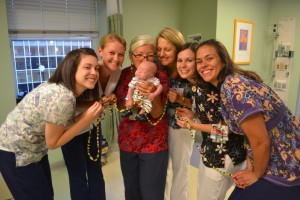Dear NICU Nurse,
To be honest, I never knew you existed. Back when our birth plan included a fat baby, balloons and a two-day celebratory hospital stay, I had never seen you. I had never seen a NICU. Most of the world hasn't. There may have been a brief, "This is the Neonatal floor" whilst drudging by on a hospital tour. But no one really knows what happens behind those alarm-secured, no-window-gazing doors of the NICU. Except me. And you.

I didn't know that you would be the one to hold and rock my baby when I wasn't there. I didn't know that you would be the one to take care of him the first five months of his life as I sat bedside, watching and wishing that I was you. I didn't know that you would be the one to hand him to me for the first time, three weeks after he was born. That you would know his signals, his faces, and his cries. Sometimes better than me. I didn't know you. I didn't know how intertwined our lives would become.
I know you now. I'll never be able to think of my child's life without thinking of you.
I know that in the NICU, you really run things. That your opinions about my baby's care often dictates the course and direction or treatment as you consult with the neonatologist every day. I know that you don't hesitate to wake a sometimes-sleeping doctor in the nearby call room because my baby's blood gas number is bad. Or because his color is off. Or because he has had four bradys in the last 45 minutes. Or because there's residual brown gunk in his OG tube.
I know now that you are different from other nurses.
I know that, at times, you are assigned to just one baby for 12 hours straight. You are assigned to him because he is the most critically-sick and medically fragile baby in the unit. I've seen you sit by that baby's bedside for your entire shift. Working tirelessly to get him comfortable and stable. Forgoing breaks while you mentally will his numbers to improve. I've seen you cry with his family when he doesn't make it. I've seen you cry alone.
I've seen you, in an instant, come together as a team when chaos ensues. And let's be honest, chaos and NICU are interchangeable words. When the beeper goes off signaling emergency 24-weeker triplets are incoming. When three babies in the same pod are crashing at the same time. When the power goes off and you're working from generators. In those all too often chaotic moments, you know that time is more critical in this unit than any other, and you don't waste it. You bond together instantly as a team, methodically resolving the crisis until the normal NICU rhythm is restored.
Yes. I know you now. I'll never be able to give in return what you have given to me. Thank you for answering my endless questions, even when I had asked them before. Thank you for your skill; you are pretty great at what you do. Thank you for fighting for my baby. Thank you for pretending like it was normal when I handed you a vial of just pumped breast milk. Thank you for agreeing to play Beatles lullabies in my baby's crib when I was gone. Thank you for waking the doctor. Thank you for texting me pictures of my sweet miracle, even when it was against hospital policy. Thank you for crying with me on the day we were discharged.
Most of the world still doesn't know what you do. They can't understand how integral you are to the positive outcomes of these babies who started life so critically ill. But I do. I know you now. I will never forget you. In fact, our story can never be told without mentioning you. So the next time you wave your access card to enter the place that few eyes have seen, know that you are appreciated. I know you, and you are pretty amazing.
Your fan forever,
A NICU mom
This post originally appeared on Preemie Babies 101
Source: Huffington Post


 incorrect or incomplete, the wrong treatment may be prescribed and patient harm can occur.
incorrect or incomplete, the wrong treatment may be prescribed and patient harm can occur. important to examine how male nurses are portrayed in popular culture.
important to examine how male nurses are portrayed in popular culture.





